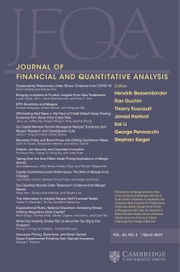No CrossRef data available.
Article contents
Index Investing and Asset Pricing Under Information Asymmetry and Ambiguity Aversion
Published online by Cambridge University Press: 11 August 2025
Abstract
In a setting with a tradable value-weighted market index, ambiguity-averse investors do not trade, and the index is not mean–variance efficient. But when a passive fund offers the risk-adjusted market portfolio (RAMP), whose weights depend on information precision as well as market values, investors share risk via index investing and effectively hold the same portfolios as in the economy without model uncertainty. This follows from a new Information Separation Theorem: equilibrium portfolios are the sum of RAMP, which is the optimal portfolio conditional on public information, and their optimal private-information-based portfolios. RAMP is in equilibrium mean–variance efficient.
Information
- Type
- Research Article
- Information
- Copyright
- © The Author(s), 2025. Published by Cambridge University Press on behalf of the Michael G. Foster School of Business, University of Washington
Footnotes
We thank Thierry Foucault (the editor) and two anonymous referees for insightful comments and suggestions. We also thank Hengjie Ai, David Dicks, Stefanos Delikouras, David Easley, Bing Han, Zhiguo He, Jiasun Li, Ye Li, Olivia Mitchell, Stijn Van Nieuwerburgh, Uday Rajan, Yushui Shi, Chen Wang, Yajun Wang, Liyan Yang, and seminar and conference participants at UC Irvine, the National University of Singapore, Hong Kong Polytechnic University, the 2016 CFEA, 2017 AFA, 2017 FIRS, 2018 WFA, 2018 SITE, 2019 SFS Cavalcade, and 2019 Mitsui Finance Symposium for very helpful comments.

